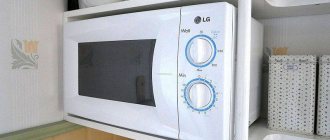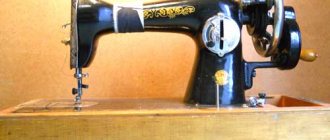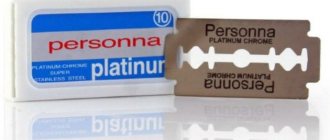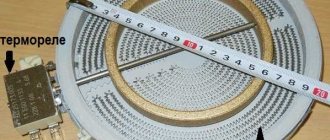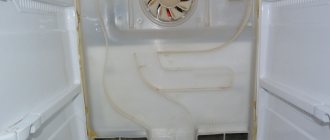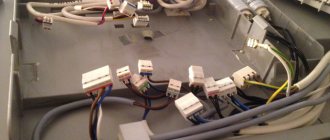What is a toaster and what is used to cook with it?
The word “toast” comes from the English toast and refers to thin slices of dried or lightly browned bread served for breakfast. To quickly prepare toast without overcooking it, special ovens have been invented - toasters. Toasters come in three main types: classic toaster, toaster roaster and sandwich toaster.
Classic toaster
A classic toaster is a vertical box with narrow slots. Inside there are baskets in which pieces of bread are placed. The user presses a lever, the baskets are lowered and locked in the lower position, and the bread is placed between the heating elements.
The finished toast is thrown out by a spring
As soon as the timer goes off, the heating stops and the spring returns the basket to the top position. Ready toasts appear from the cracks, you can have breakfast.
Toaster-roaster
You can brown pieces of bread in a regular oven, but heating up the oven just for a couple of loaves of bread for breakfast is ineffective. The industry produces mini-kitchen ovens (volume no more than 20 liters), which are also called “roasters” (from the English roast - to fry).
The bread is placed horizontally in the mini-oven roaster.
The bread in the roaster is positioned horizontally between the upper and lower heating elements. Unlike a toaster, a roaster can heat sandwiches and pizza, fry sausages and sausages.
Sandwich toaster
A classic toaster can only dry and brown bread slices. Since the bread in it is installed vertically, it is impossible to make a full-fledged hot sandwich in a toaster - the ingredients will fall down. A special sandwich toaster can make a real sandwich.
In a sandwich toaster, bread and filling are baked between hot panels
This device looks more like a waffle iron than an oven or toaster. The assembled sandwich is placed on the bottom panel and covered with the top panel. Both panels are heated, so the sandwich bakes evenly on top and bottom, turning into a flat pie. The shape of the sandwich is given by the recesses in the panels.
Frequent breakdowns
Service center specialists deal with toaster repairs more often than owners of individual appliances. Many services have statistics on breakdowns for which owners contacted specialists. All cases are divided into two groups: one is related to mechanics, the second to electrical.
Lifting mechanism failure
If the lifting mechanism cannot be lowered all the way down, the problem is often that too many crumbs have accumulated at the bottom. After cleaning the appliance, the situation does not repeat itself as long as you monitor the condition of the toaster. Occasionally, the lowering of the lift is blocked by foreign objects that have gotten inside. If there are small children in the house, place the device so that they cannot reach it.
Sometimes the reason is that the bread slices are too wide. Try not to exceed the recommended piece sizes.
Magnetic coil problems
The release coil is responsible for holding and releasing the toaster lift mechanism. For many manufacturers, it can only be replaced together with the board, so if this part breaks down, the technicians themselves often advise against repairing it. It's cheaper to just buy a new toaster.
Thermal sensor failure
Some toasters have a temperature sensor that allows you to control the degree of toasting. If it fails, the toast will brown unpredictably - too much or too little. The problem is solved by replacing the part. It is often difficult to find an original element, so owners have to either agree to install a part from another manufacturer, or go for new equipment.
Mechanical latch failure
You may encounter this problem several years after purchasing a toaster. It usually occurs due to wear of the part. A worn part does not fire on time. Whether it is worth changing depends on the circumstances. If you have an expensive toaster with a beautiful design, you might want to consider refurbishing it. But in most cases, wear of mechanical parts indicates the advanced age of the device, so repair is not always advisable.
Failure of the heating element or heating elements
The symptoms are very characteristic: the slices are not fried at all or are fried only on one side. Heating elements sometimes burn out. This happens when the appliance is used too intensively, for example, when preparing a large amount of toast for a holiday dinner. Replacement is quite expensive.
Problems with the power cord
A fairly common problem is damage to the power cord. It may look completely normal on the outside, but underneath the insulation layer one or both wires may be broken. This happens in several cases:
- a heavy weight was placed on the wire;
- when unplugging the device from the outlet, owners do not hold on to the plug, but to the cord itself;
- in private homes, rodents can chew the insulation if drops of oil or other products come into contact with it;
- The insulation melted because the toaster was too close to the cooktop or other appliances with heating elements.
This problem can be solved without major expense; you just need to replace the power cord.
Power button doesn't work
With frequent use, the button may begin to stick or, conversely, no longer stay in the “ON” position. The simpler the button, the easier it is to find a spare part in the event of a breakdown. If you choose a designer toaster, restoring the original power button will not be easy.
Oxidation of contacts
This trouble can occur in different areas. The symptoms depend on the location of contact oxidation: a certain function will not work or the toaster will not turn on at all. Fortunately, you can clean the contacts within a few minutes, after which the device will be ready for use again.
How does a toaster work and how does it work?
A classic toaster is a closed case with slots, inside of which there are heating elements, as well as a movable bread basket. To prepare, the slices are placed in a basket.
Toaster diagram. Non-working (upper) position
The diagram shows the following parts of the toaster in the non-operating position:
- Lever arm. Used to lower the bread basket and turn on the appliance.
- Heater. Hot nichrome wires heating the bread.
- Breaker. Placed on the building and about. Designed for emergency power outage and early termination of cooking.
- Lock. Locks the basket in the down position.
In the off state, the lever (1) is in the upper position, the heating coils (2) are turned off, the circuit breaker (3) is closed, and the basket is raised. The basket lock (4) is open.
The breaker is needed in order to forcibly break the power supply circuit of the electromagnet and interrupt the process if something goes wrong.
Toaster diagram. Working (lower) position
The diagram shows the following parts of the toaster in operating position:
5. Hot coil heater. Emits heat that bakes bread.
6. Movable basket. Lowers the product to the heater.
7. Locking plate. Holds the basket during cooking.
8. Electromagnet. Magnetizes the locking bar while the bread is cooking.
9. Wedge-shaped plate. Closes the contacts when the basket is lowered.
When the user presses the lever, the basket (6) moves down, and the following processes occur simultaneously:
- A wedge-shaped plastic plate (9) lowers and pushes the spring contacts.
- The spring contacts close and turn on the control circuit, heaters and electromagnet.
- The electromagnet creates a magnetic field that magnetizes the bar (7) to the core, thereby locking the basket (6) with the lock (4) in the lower position.
- The control circuit starts the countdown timer.
Infrared radiation (5) warms the bread until the timer goes off. As soon as the cooking time has expired, the control circuit removes power from the electromagnet, the basket is released from engagement and returns to the upper position under the action of a spring. The wedge-shaped plate (9) releases the spring contacts, they open and turn off the heaters and the control circuit.
Video: demonstration of the toaster operation
Repair with passion.
Hello repairmen! Let's talk about the intricate repair of a toaster, in detail about the operating principle of its electrical and electronic fillings, about the interesting power supply of the control board and about the layout of electrical parameters at the control points of the circuit.
toaster (board FTC-208 shch-4 GW12) came to me as a gift, not in working order and without a power cord. Externally, the button and knob were fine. I opened it, washed the plastic case from sticky dirt, examined it with a careful eye, everything was in order. I removed the board, turned it over in my hands - everything was fine too. It was useful to take voltage measurements - it turned out that the power supply did not come to the board when I pressed the main large button-lever.
Front view
As usual in toasters, this lever, also known as a button, supplies power to the electrical network for the entire unit. And as usual in toasters, the low-voltage power supply to the board is provided by ATTENTION! …. THE HEATING ELEMENT ITSELF, i.e. part of its turns (you will see in the diagram)! No transformers or AC-DC converters for you!
I personally like this simple and reliable solution!
I measured the integrity of this heating element with an ohmmeter and found that it was broken. I started digging for a metal stand with a thermal wire wound in it. I came across a break at the fastening rivet (broken off) to this very wire.
Again, as is usually the case in toasters, the structural parts of the stand with nichrome wire are connected to each other by metal jumpers, which in turn are welded by contact welding! In such cases, this usually complicates the repair, since not everyone has a resistance welding machine at hand, and instead, using collective farms for something like twists or “on screws” and terminal blocks, in this case it is a thankless task, fraught with overheating and oxidation contacts.
I had to restore this break without destroying this same contact welding, simply manipulating the tool like a surgeon!
Since a small part of my wire had burned off, the length of the rest was no longer enough to restore contact, and it was not possible to rewind everything at all due to the lack of such a flat heating wire. Therefore, I had to slightly pull and tighten it.
To do this, I cut and deepened the mica base from the opposite side in the slots in two places (these slots hold the wire at turns) and thus the wire was pulled to the rivet with the necessary margin.
Thermal wire tension
Anticipating your sensible exclamations that they say: “So it will burn out again later”!!! – I retort – what could I do, for the above reasons?
After repairing the toaster, go to my mother-in-law... :-), I’ll tell her to use it without overloading, and as they say, “I’ll take a look”!
Also, to prevent the wire from burning out, the new power cable was deliberately set with a cross-section of 0.75 mm (ShVVP-0.75) in order to reduce the load on the heating element and thereby extend its life.
Instead of a rivet, I installed a regular screw, washers, a screw, a nut and clamped the wire with them.
Before and after restoration of the thermal wire
Turned it on, tested it, it works.
For clarity, I drew a diagram from the board.
Just in case, I checked the capacitors, etc., everything turned out to be normal. I took measurements from control points, current and voltage, and the resistance of the heating elements - maybe some of you, dear ones, will find it useful.
Board diagram with measurements at control points
The scheme is interesting, simple and therefore reliable. As I wrote earlier, the board is powered from a small part of the turns of the heating element, i.e., removing the reduced voltage. The voltage rectified by the diode is supplied to the smoothing capacitor C1 connected in parallel with the resistor R8 that discharges it when the toaster is turned off. R7 lowers the voltage to the required limit to power the timing circuit.
C2, R4, R5, W is actually the timing circuit itself. C2, discharging to the required current level (as is known, bipolar transistors are controlled by current), closes transistor Q1, which closes Q2, which in turn closes Q3, and the latter turns off the relay.
R6 discharges the condenser, for the clarity of the circuit after turning the toaster on and off. It also creates the necessary voltage bias at the base of transistor Q1. Those. for the stability of its operation (so that the base does not “dangle in the air”!). R2 and R3 are collector loads and resistive dividers of the bases of Q2, Q3. R1 creates the necessary operating mode for the Q3 base.
Q3 is the direct key that controls the operation of the relay, which in turn closes and opens the power contacts and is also the collector load. D2 is installed for the stability of the circuit.
I gave it to my mother-in-law and as long as she doesn’t complain, it means the toaster is working.
This is how the renovation turned out!
For this, let you all bow to the ground until the next meeting!
Good luck with your repairs!
2
Author of the publication
offline 15 hours
Vasya
252
Thoughts tend to materialize!
Comments: 89Publications: 28Registration: 03/25/2018
How to use a toaster correctly?
A toaster is an electrical appliance with exposed heating elements. The luminous coils are heated to very high temperatures and can cause injury and ignite flammable materials.
General rules of use
- The toaster should be installed in a free space. The curtain should not hang over the cracks. Do not place the device on the edge of the tabletop, so as not to accidentally pull it down.
- The toaster only cooks dry bread. Ready-made sandwiches with cheese or sausage, soaked bread are unacceptable: they will fall, burn and clog the device.
- You can't toast anything other than bread in a toaster. There is a special toaster for preparing hot sandwiches, and a roaster is used for sausages.
- It is recommended to plug in the appliance only while making toast. Do not cover a toaster while it is running.
- If water gets on the wire, the heater coil will burst with a fireworks display of hot particles.
- The heating coils are hot and energized. You cannot check the readiness of bread with a steel fork - you will get an electric shock. If you really need to straighten a piece, use wooden tongs.
How to make toast correctly
- The spirals should not run idle - they will overheat and burn out. Occupy all the free slots of the toaster with bread.
- Choose the right bread. Homemade pieces are rarely the same; they will protrude from the grill, may touch the spirals and burn. It is recommended to take slices cut at the factory; they are always the same in thickness, so they will fry evenly.
- Toasted bread creates a lot of crumbs. Good toasters have a pull-out tray underneath the basket. After each cooking, it is recommended to shake out any crumbs. Perform general cleaning and cleaning of the toaster at least once a month.
How does a toaster work?
First, the device should be plugged into a power outlet, after which the bread cut into small slices should be placed in its stand. By pressing the slider handle, we lower the holders into the body. In parallel with this process, the heating elements located inside the housing are turned on and the “frying” time begins to count down. As soon as the time allotted for frying has expired, the heaters turn off and a mechanism is activated, pushing the holders with ready-made toast upwards.
Remember that the breads that have been in the toaster are always very hot, so when taking them out, you should take certain precautions so as not to get burned.
How to fix a toaster: won't lock in down position, won't turn off automatically
Repairing a toaster oven yourself is a simple procedure, but it requires attention. First of all, you need to study what the device consists of, find out the main possible problems and ways to solve problems.
Toaster design and device
The device for frying bread slices consists of several parts:
- metal or plastic case;
- heating coils fixed from the inside;
- a movable basket with a spring into which pieces of bread are dropped;
- a lever that lowers the compartment with toast and simultaneously turns on the heating;
- an electric magnet that is responsible for holding the basket in the lowered position during cooking.
In addition, the toaster circuit has a circuit breaker responsible for forcing the device to stop. Modern models have additional electronic components - a timer, heating regulator and buttons for switching between modes.
Many toasters have a crumb tray, but pieces of bread still accumulate inside.
How does a toaster work?
The algorithm for frying bread in a toaster is as follows:
- the user places the slices in the corresponding compartments of the device and presses the lever;
- the basket is lowered down, at the same time the plastic wedge is brought into working position;
- the spring contacts close under the influence of the wedge and turn on the electromagnet and heaters through the control circuit;
- the timer starts the countdown;
- the device warms up the bread until the electronic mechanism is activated;
- the timer opens the circuit, after which the magnet stops holding the basket;
- the spring returns the bread compartments to the upper position;
- heating coils and control circuit are disabled.
Although the operating principle of a toaster and its design are very simple, any element of the system can fail. In this case, the user will encounter one of the many problems with the operation of the device.
Possible toaster breakdowns
Toaster malfunctions can be either electronic or mechanical in nature. You can often repair the device yourself, without the help of specialists.
The toaster does not lock in the down position
One of the most common faults is the basket not being secured. In such cases, the toaster works, but the pressure spring does not hold the bread.
Most often, the device can be repaired with simple cleaning. Most likely, bread crumbs got stuck in the grooves of the lever or got on the magnetic plate that holds the basket in the down position. For repair you need:
- unplug the toaster and wait for it to cool down;
- pull out and release the tray designed specifically for collecting crumbs;
- turn the toaster upside down and shake it thoroughly;
- disassemble the unit and manually remove accumulated crumbs from the spaces between the internal parts.
Then they reassemble and put the device back into operation. If the lever is held in the down position, then the device has been repaired.
If the lever does not lock, you can simply lower it and hold it manually as a temporary measure.
The toaster does not turn off automatically
A less common problem is that the toaster does not eject bread. In this case, heating occurs in the usual way, but the lever does not return from the lower position. Frying takes longer than the allotted time, and the slices literally burn to charcoal.
Typically the problem that needs to be fixed is a faulty timer or thermostat. These elements are responsible for the reverse operation of the basket latch at the right time. If the bimetallic plate of the thermostat does not correctly determine the temperature inside the appliance, or the timer does not send a shutdown signal on time, the toaster must be sent for service. It will not be possible to repair it at home without special skills, since the control circuit needs to be repaired.
Advice! If the toaster breaks down and does not turn off, and you cannot urgently take it to service, you can only stop the device manually using the “Stop” button.
Toaster won't turn on
In some cases, the toaster simply refuses to start working. Typically, failure is caused by two reasons:
- The device is not receiving power. Before you try to fix the toaster, you need to make sure that it is basically plugged into the outlet. Then you should inspect its wire and plug for twisted, frayed and darkened areas. If the cable is damaged, it can be repaired by replacing it - to do this, you need to remove the device case and solder a new wire to the control board.
- The contacts on the electronic circuit responsible for putting the device into operation have oxidized or burned. To repair a toaster, you also need to remove the casing and carefully inspect the control board. Darkened elements are carefully cleaned with fine sandpaper.
Attention! Any work on the toaster's electronic board is carried out only after disconnecting the device from the network.
The coil does not heat up
If the spiral malfunctions, the toaster successfully fixes the basket when turned on. But at the same time, the heating elements inside remain cold and do not begin to glow even after several minutes.
If the spirals in the device are of the infrared type, in the form of glass tubes, then you cannot repair them with your own hands. The device must be taken to service so as not to break completely.
If the heater is wire, then the damage can be repaired at home. To do this you need:
- disassemble the unit, remove the mica plate with the nichrome wire wound on it and visually find the location of the break or short circuit;
- if the heater looks completely fine, use a multimeter and measure the resistance;
- Having identified the problem area, straighten the torn sections of the wire;
- twist the ends and apply a kind of bandage made of thin copper cable, crimping it with side cutters.
Important! It is quite possible to repair a wire heater, but it may soon fail again. In this case, you will need to completely replace the elements.
The roasting regulator does not turn on
The frying regulator in the toaster is responsible for the degree of heating of the bread, as well as for automatically turning off the device. The element can be mechanical or electronic:
- The mechanical regulator is a bimetallic plate. When heated, it bends and, after reaching a given temperature, opens the contacts. Most often, the element breaks due to blockage. To repair the regulator, you need to remove the casing and manually free the mechanism from accumulated crumbs.
- An electronic regulator in the form of a resistor is located on the control board of the device and connected to the handle on the body. If the handle does not turn or is too tight, you can dismantle the device casing and clean the chip from bread crumbs.
Attention! A bimetallic plate of a mechanical type may simply bend if the device is used intensively. It cannot be repaired; the toaster must be sent to service to replace the regulator.
The toast is not cooked through
A toaster may work properly, but it may not heat the bread well and not provide a golden crust. The malfunction can be caused by several reasons:
- insufficient heating temperature; to correct the problem, it is enough to set the frying regulator correctly;
- the basket is distorted due to clogging of the internal mechanisms; in order to repair the device, you need to disassemble it and free it from crumbs, returning the holders, springs and levers to free movement.
It happens that the failure is caused by a timer error and the device turns off too early. It is difficult to repair such a toaster; to correct the error, you need to send it for repair, since the electronic board needs to be configured.
Toast may not be cooked through due to the lever not being lowered completely.
